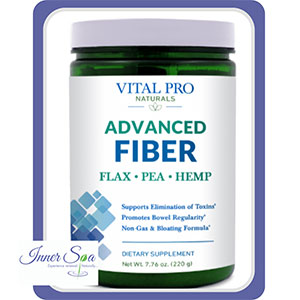Welcome to the first of our 4-part series covering gut health.
We’ll cover the H.O.P.E. system that helps keep the gut in balance with Hi-Fiber, Omega-3s, Probiotics, and Enzymes. Today is all about Hi-Fiber, including a delicious fiber-rich recipe (see recipe post here) to try.

Hi-Fiber is a Gut’s Best Friend
Dietary fiber is a plant-based nutrient which is sometimes called ‘roughage’ or ‘bulk.’ It includes the parts of plant foods your body can’t digest or absorb. Unlike other food components, such as fats, proteins or carbohydrates — which your body breaks down and absorbs — fiber isn’t digested by your body. Instead, it passes relatively intact through your stomach, small intestine and colon, and out of your body. However, on its journey, fiber does a lot of work.*
According to digestive health expert Brenda Watson, “Clinical research has proven that people who consume a diet high in fiber are less likely to suffer from constipation, irritable bowel syndrome, gastroesophageal reflux disease, and a host of other digestive disorders. High-fiber diets can also help protect your gastrointestinal system from parasite infestation.”
Do you get enough fiber? Research suggests that most Americans do not. According to Watson, we should consume 35-40 grams of fiber per day. Increasing your fiber intake may be beneficial for you, and if you decide to start boosting your numbers, make sure to drink plenty of water, too.* Increased fiber without enough water, especially if your body is not used to it, could backfire and cause constipation and cramping. You need the water to help flush out the extra fiber intake.
There are two types of fiber – soluble and insoluble. It’s important to know the differences between the two and how each type of fiber behaves in your body. Here are the basics:
Soluble fiber:
- Dissolves in water
- In the body, dissolves into a gel-like substance
- Soaks up toxins as it moves through the digestive tract*
- Helps decrease blood sugar levels*
- Helps lower cholesterol*
- Sources: beans, lentils, barley, oatmeal, peas, citrus, blueberries, apples
Insoluble fiber:
• Does not dissolve in water
• Speeds up the passage of food through the digestive system
• Prevents constipation*
• Helps sweep away toxins*
• Increases fecal bulk, which makes stools easier to pass.*
• Sources: whole-wheat flour, wheat bran, brown rice, cauliflower, potatoes, tomatoes, cucumbers.
It’s important to strike a balance of insoluble and soluble fibers so you get the best of both. Pay attention to how your body responds to fiber (or the lack thereof) and notice the effects of making fiber your friend.
As with many good-for-you foods and supplements, whole foods are wonderful and moderation is key. How will you add hi-fiber foods to your daily meals? Gradually is best; add a bit each day and increase your serving sizes a little at a time.
Watching your calorie intake? Or maybe you just don’t enjoy many of the hi-fiber food sources. Consider supplementing with our Vital Pro Naturals Advanced Fiber. We’ve researched and sampled many suppliers, and this is THE ONE we trust and use.

- It contains a blend of both soluble and insoluble fiber from natural sources like flax, pea, and hemp and does not contain Psyllium.
- This organic fiber powder helps support healthy digestion, as well as the elimination of waste and impurities.
- You’ll find it easy to mix into your favorite drinks for a convenient way to increase your daily fiber intake.
- Advanced Fiber is a non-gas and bloating formula, with 13 grams of fiber per serving.
- It is Non-GMO, Gluten Free, and Vegan.
Advanced Fiber is a powder so you can adjust your intake. Measure smaller amounts to begin and gradually work up to the recommended 2 scoops per day for 22g of balanced fiber.
Available in-spa for $25/canister. Call ahead for quick pick-up. 215.968.9000

Three things to do this week:
1. Determine your water intake goal and set up your optimal amount each morning. (One-half of your body weight in ounces.) Set it up in a way that you’ll actually use. Maybe that’s one large container that you take everywhere or 4 water bottles spread out through your workspace, home and car, or even an app on your phone. . . what works for you will work.
2. Seek high fiber recipes to try. Search online or see if your favorite grocery store offers recipes in their app.
3. Visit your local Farmer’s Market or produce store to buy a few new-to-you fruits and vegetables.
*These statements have not been evaluated by the Food & Drug Administration. This information is intended to inform only. It is not intended to diagnose, treat, cure, or prevent any disease or condition. Always consult your healthcare provider.